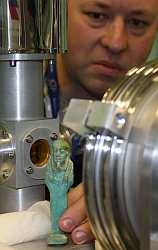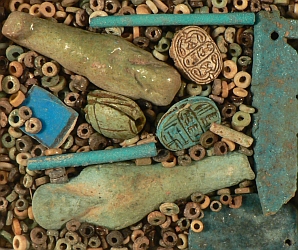Have you heard the one about the archaeologist, the physicist and the mineralogist? It’s not just the beginning of a good joke, it’s a team using the Australian Synchrotron to help reveal the methods used to make ceramics and jewellery in ancient Egypt during the reign of Pharaoh Akhenaten.
La Trobe University archaeologist Mark Eccleston is investigating the use of metals, primarily copper and copper alloys such as bronze, in Egypt during the New Kingdom (from around 1500 to 1100 BC). The work focuses on the site of Amarna, which was established as a royal capital during the reign of Pharaoh Akhenaten, who completely revolutionised Egypt’s religious and political landscape.
“Amarna was only occupied for about 25 years,” Mark says. “So it’s a unique time capsule of life at around 1350BC.”
 Recent excavations at Amarna show that the metalworking industry and the faience industry were sometimes located together. Faience is a quartz-based, glazed material that is often light blue or green in colour due to copper or bronze.
Recent excavations at Amarna show that the metalworking industry and the faience industry were sometimes located together. Faience is a quartz-based, glazed material that is often light blue or green in colour due to copper or bronze.
“I’m interested in how the workshops were organised and what raw materials they used. One thing we’d like to know is whether the copper was added to the glaze mixture as a metal, a mineral or in some other form. At present this is not known, but it has been speculated that it was metals and not a mineral. We hope synchrotron techniques will give us a better understanding of the chemistry and mineralogy of the copper in the faience so we can prove this one way or the other.”
From a broader perspective, identifying the raw materials will also provide insights into the micro-economic aspects of the industry, trade and distribution of raw materials in the wider economy and how different trade activities were organised within wider city life.
Mark is working closely with La Trobe physicist Peter Kappen, with assistance from Museum Victoria mineralogist Dermot Henry, and Kia Wallwork and other beamline scientists from the Australian Synchrotron.
Mark and Peter are using the x-ray absorption spectroscopy (XAS) and powder diffraction (PD) beamlines at the Australian Synchrotron with additional XAS studies at HASYLAB (Hamburg synchrotron radiation laboratory) in Germany.
Mark says their latest visit to the Australian Synchrotron XAS beamline, in June 2010, has “advanced our knowledge of the structure of faience and allowed us to direct future research proposals to target areas of interest identified in work to date.
“It has also been an invaluable pilot project in relation to working with museum collections, as we’ve been able to demonstrate quite convincingly the ability to analyse whole objects in the beamline.”
“Based on our powder diffraction results at the Australian Synchrotron, we’re hoping to actually fire some replica faience in the PD beamline's new furnace and monitor the change in structure over time. We’ll start with a known group of materials and see what they look like after taking them to 900 degrees.”
Mark and Peter will travel to HASYLAB in September for XAS work.
“One of the main reasons for going to Germany is to collaborate with the Neues Museum in Berlin, which has a major collection of material from Amarna. It’s now impossible to export samples from Egypt for analysis, so accessing a collection outside of Egypt that is very well-documented in regard to where it was found is very important to being able to make some conclusions that relate to the industry at a specific site and time period in history.”
The HASYLAB results will contribute to a reference database of results that the team can use to plan future work on the PD and XAS beamlines at the Australian Synchrotron.

Mark Eccleston from La Trobe University is studying ancient Egyptian artefacts coated with a blue-green glaze called faience.
